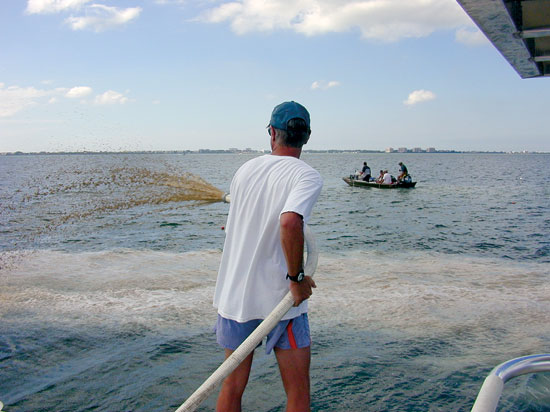
In April 2022, an experiment was conducted at the Mote Marine Lab Florida Red Tide Mitigation and Technology Development Initiative indoor mesocosm facility in Sarasota, FL to determine the effectiveness of using clay as a possible treatment for reducing the effects of harmful algal blooms (HABs) in Florida. The results from this experiment, published in Harmful Algae, found that clays are an effective method to reduce the effects of HABs on our marine ecosystems. HABs regularly disrupt ecological processes and local economies along the coasts of the Gulf of Mexico. HABs occur almost annually on the west coast of Florida, persisting for weeks, months, or even years. In addition to inducing cloudy and low-oxygen conditions, HABs can also produce neurotoxins, which directly or indirectly affect every level of the marine food web, inflicting mass mortalities in fish and other marine animals. In Florida, each bloom event can result in the loss of millions of dollars to the local economy.

Bloom control strategies can be used alongside other management techniques, such as nutrient reduction and long-term monitoring, to reduce the damaging effects of HABs. Clay-based “flocculants” (a substance that makes fine particles clump, or aggregate, together) are used globally as a method of controlling harmful algal blooms, and their use is currently under consideration to control Karenia brevis blooms in Florida.
Using the mesocosm tanks, researchers evaluated the chemical dynamics and lethal and sublethal impacts of the clay over 72 hours on a benthic community representative of Sarasota Bay, which included blue crab, sea urchin, and hard clam. The application of clay successfully removed K. brevis cells but was less effective at toxin removal than expected. The clay also removed dissolved and particulate phosphorus from the water column, and significantly reduced pH and alkalinity over the 72-hour observation period. The lethal and sublethal responses to clay-treated K. brevis did not differ from untreated K. brevis for either of the three species at any time point, suggesting clay treatment at this dosage has negligible impacts to these species within 72 h of exposure.
In concept, clay particles aggregate with algal cells, quickly and efficiently removing the majority of bloom biomass from the water column. Clays have also been shown to be effective at removing HAB toxins. Compared to alternative methods of bloom control, such as algicidal bacteria, clay is inexpensive, abundant, and thus far has shown minimal environmental impacts, which makes this method an attractive option for large-scale use. Extensive research has been conducted to develop formulations of clay that are harmless to non-target organisms at effective treatment concentrations. In several cases, clay treatment of HAB species has been shown to reduce mortality rates of co-occurring organisms compared to those exposed to untreated bloom conditions.
Scientists from the University of Central Florida, Mote Marine Laboratory, Woods Hole Oceanographic Institute, and the University of Rhode Island carried out this experiment and conducted analyses. This work is part of a joint effort between NCCOS and Mote Marine Lab that is leveraging funds from the Prevention, Control, and Mitigation of Harmful Algal Blooms Program and Florida Red Tide Initiative to develop and test the effectiveness of HAB control methodologies.
